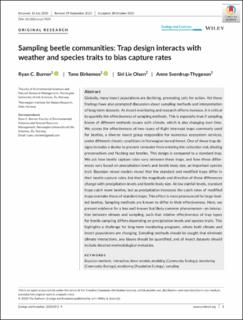| dc.description.abstract | Globally, many insect populations are declining, prompting calls for action. Yet these findings have also prompted discussion about sampling methods and interpretation of long‐term datasets. As insect monitoring and research efforts increase, it is critical to quantify the effectiveness of sampling methods. This is especially true if sampling biases of different methods covary with climate, which is also changing over time. We assess the effectiveness of two types of flight intercept traps commonly used for beetles, a diverse insect group responsible for numerous ecosystem services, under different climatic conditions in Norwegian boreal forest. One of these trap designs includes a device to prevent rainwater from entering the collection vial, diluting preservatives and flushing out beetles. This design is compared to a standard trap. We ask how beetle capture rates vary between these traps, and how these differences vary based on precipitation levels and beetle body size, an important species trait. Bayesian mixed models reveal that the standard and modified traps differ in their beetle capture rates, but that the magnitude and direction of these differences change with precipitation levels and beetle body size. At low rainfall levels, standard traps catch more beetles, but as precipitation increases the catch rates of modified traps overtake those of standard traps. This effect is most pronounced for large‐bodied beetles. Sampling methods are known to differ in their effectiveness. Here, we present evidence for a less well‐known but likely common phenomenon—an interaction between climate and sampling, such that relative effectiveness of trap types for beetle sampling differs depending on precipitation levels and species traits. This highlights a challenge for long‐term monitoring programs, where both climate and insect populations are changing. Sampling methods should be sought that eliminate climate interactions, any biases should be quantified, and all insect datasets should include detailed methodological metadata. | en_US |

